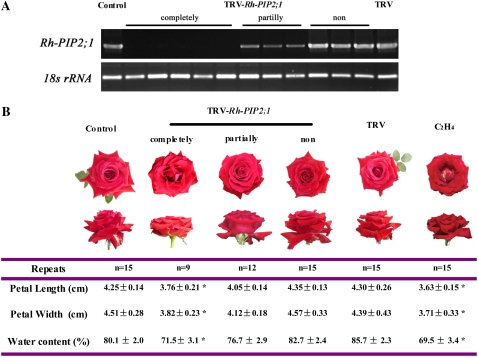Figure 7.
Silencing of the Rh-PIP2;1 gene in rose petals by VIGS. Rose branches were infiltrated with Agrobacterium containing TRV alone (TRV, pTRV1 + pTRV2) or TRV carrying a fragment of Rh-PIP2;1 (TRV-Rh-PIP2;1, pTRV1 + pTRV2-Rh-PIP2;1). A, RT-PCR analysis of Rh-PIP2;1 in the Rh-PIP2;1-silencing flower petals. The first-strand cDNA was generated from 1 μg of total RNA and was used to amplify Rh-PIP2;1 and the 18S rRNA gene using gene-specific primers. The PCR cycles was 27 and 18 for Rh-PIP2;1 and 18S rRNA, respectively. Completely, Completely silenced flowers; partially, partially silenced flowers; non, no silenced flowers. B, The phenotype of Rh-PIP2;1-silencing flowers (top) and petal sizes and water content (bottom). The photographs were taken on the 7th d after infiltration. The petal size and water content were determined on the 7th d after infiltration as described in Figure 1. Each data point represents the mean ± se (n = 15 for control, TRV-Rh-PIP2;1 [non], and TRV; n = 9 for TRV-Rh-PIP2;1 [completely]; n = 12 for TRV-Rh-PIP2;1 [partially]).

